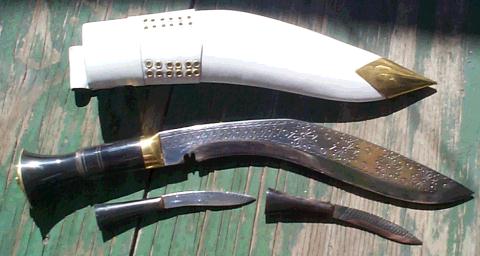
Bishwakarma is the name of steel working kamis. There are thousands
of them. Sunar is the name of gold working kamis. Sun (soon pronounciation)
means gold. There are a great many Sunars, also.
Ram Bahadur Bishwakarma is a completely different man than Lal Bahadur
(Bura).
Every Sherpa, about 250,000 of them, is named either Sherpa or Lama for a last name. It is sort of like your Jones and Smith name here.
Everybody in the shop calls me simply "Pala." I think some do not know my real name and that is okay.
KAMI SHERPA
This is a typical profile of a master kami.
The master kami was born a kami in both caste and work. For as long as anybody can remember his forefathers were kamis. At perhaps age 5 or 6 he begins helping his father and grandfather in the arun. He learns to pull the chain on the bellows. He gathers charcoal. He brings water for the quenching pitcher. He learns the names of tools and procedures.
At around 12 years of age he is using the hammer and does much of the pounding of steel that goes on in the shop. He can make a few simple farm implements by himself. Sometimes his effort produces a quality tool, sometimes not.
By the time he is 20 he can fire up the shop by himself and can produce many items. He can make a decent khukuri by himself but it sometimes will not be perfect.
At 30 we can call him an intermediate.
At around 40, depending on the person, he is just about ready for master kami status. The grandfather has left his body and his father is too old to do much work so it is on his shoulders to take over the operation of the arun. At this stage he has made every farm tool that can be made. He can make a perfect khukuri 99% of the time. He understands steel and knows how to work it. He has made hinges for gates and cabinets. He has made prybars and wedges. He has made sickles, sythes, axes, rakes and hatchets. He can make rings, bracelets, ear rings, pliers, tongs, awls, nails, needles, metal baskets, and rivets. If you show him a sketch of something you want made and give him a few verbal instructions he can produce what you want.
He talks with you as he works and often chuckles and sometimes swears. He may pause to take a sip of rahksi and will offer you a drink. You are amazed at how easily, quickly and skillfully he performs his work. It is a pleasure to watch him and you realize that his is a true artform. He will tell you about things his grandfather made -- perhaps a lock for a door with a handmade key for entry. And, he will tell you he is probably the best kami in Nepal or at least the best in his district. Then you know that here is a true master kami.
BILL MARTINO 7/24/99
The kami's at BirGorkha began marking their blades with distinctive marks 2/2000. HW
Also see "The World of the Nepal Kami's," picture essay on the HI website.
Sanu (Shorty) Bishwakarma [mark of the cross]


a collaboration here of kami Sanu Bishwakarma and our master sarki, Kamar Sarki, who said "if you give me the leather and some time I can make a better scabbard than anybody in Nepal."
Kamar may have done just that and Sanu has provided us with 18.25 inches and 2.25 lb of dynamite khukuri, half inch thick and two inches wide. It is up to his usual standards, excellently crafted and hardened. He has put a stars motif and hatchmarks as shown. Karda and chakma are 6 & 1/2 inches, excellently done and hatchmarked.

Here is a 19 inch foward curving model by Sanu. Blade is 9/16 thick and two inches wide. Very nicely finished and hardened. Nice designs on the blade -- deep cut and neat. Weight is 2 & 1/4 pounds. Big, tough khukuri. Karda and chakma are 7 inches and well done.
Sanu has been with us for awhile. Gelbu recruited him on an early recruiting journey to various villages. The story goes like this.
Gelbu ran across Sanu is some small village -- don't know the name, and Sanu was having a hard time of it. Unlike many kamis he owned no land and was living in a small rented mud hut and had his shop located outside in the dirt. He is perhaps 35 or 40, married with a couple of kids. He had only a couple of khukuris in stock and was out of steel and other supplies. Gelbu looked at the khukuris and they were pretty good so he bought them.
Sanu complained that he had not had enough work to meet expenses and he had been forced to borrow 10,000 rupia just to stay alive. He did not have enough money left to buy food or steel so he was mightily pleased to receive payment for the last two khukuris he had in stock. I think these two khukurs came in our first shipment of village models so somebody out there has them but I don't know who.
During their conversation Sanu discovered that we were just getting shop 2 on the air and asked for a job. Gelbu told him to come along and return with him and speak with Pala. Sanu readily agreed.
Upon his arrival in Kathmandu Sanu told Pala his story and asked for work. To his great credit Pala gave Sanu 15,000 and told Sanu to return to his village, pay his debts, load up his wife and kids and return to Kathmandu for work.
And to the great credit of Sanu he did exactly as he was told. He has worked very hard and just before Pala left for the US Sanu repaid the last of the 15,000 rupia Pala had loaned him.
There are three very important considerations here.
The first is the great trust and generosity shown by Pala. One of the "benefits" I mentioned offered by shop 2 that are unheard of in other shops. Remembering that the per capita income in Nepal is about $150 per year the amount Pala loaned Sanu was more than $200 or well above the per capita income. In the US the equivalent would be perhaps $20,000.
The second consideration is the fact that Sanu repaid the loan quickly -- in about three months. He is a man of honor and integrity and I am proud to have such a man working in shop 2. He has earned my admiration and respect.
And, third, and something that is very near and dear to my own heart is that by working at shop 2 and doing a good job Sanu made enough money to repay the loan in three months. He was taking good care of his family and was still able to put aside 5,000 per month for loan payment. Boys, I have been there and I can tell you from personal experience that Sanu is making BIG money for a kami and God bless him.
BILL MARTINO
Lal Bahadur (Bura) Bishwakarma - Royal kami [mark of the cresent moon]


The Royal kami, the old master kami who makes khukuris for the king
of Nepal and his top ranked cohorts came to shop 2 and made me a "royal"
khukuri, (above). He was puttering around shop 2 for 15 days. I asked his
name and Kami said, "I don't know. His nickname is Bura (old man) and that's
what we call him." BILL MARTINO
The day I left I appointed the Royal Kami to the position of shop foreman. He is the best kami we have and is an old man who knows much. Further, he is a good man and will be able to offer a lot of help and good advice to my son, Gelbu, who still has a lot to learn. I instructed Gelbu to listen to him closely and follow his good advice.
Last night when we spoke with Gelbu I found out his name. It is Lal Bahadur Bishwakarma but everybody will still call him "Bura", including me, and he is the newphew of Ganga Ram Bishwakarma who is in charge of making the Ganga Ram specials.
Being the Royal Kami has honor but the work is far from steady. The king and his top aides only need a few khukuris. Now Bura will have steady work and if the king wants a khukuri made we will simply do it in shop 2. Perhaps we have accidentally become the Royal Arun (shop)!
KAMI SHERPA

Here's Bura, the Royal Kami and BirGorkha foreman, and Uncle Bill standing outside the shop. Bura is the short fellow. I'm the little taller one.
I guess Bura (real name is Lal Bahadur Bishwakarma) is five two or three and weighs maybe 115 pounds but he can swing a mean hammer and he knows how and where to hit hot steel. He's good. He knows more and thinks better than anybody in the shop which I suppose is why he's foreman. It may surprise some to learn that he has three wives and children by all of them. Maybe that's why he shows up for work everyday. But come to think of it if I had three wives I'd not be able to show up for work -- ever.
Bura is about 45 and has 35 years experience as a kami. He lives in Swayambu and commutes to work via bus -- about a one hour journey each way. Lucky for Bura, I guess, he has a very short walk to the bus. Same from BirGorkha. Bus stop is only five or ten minute walk. He gets to work about six AM and leaves about 6 PM. He is very steady and a no nonsense guy. He comes to work to make khukuris, not to smoke cigarettes and drink tea. He is not our top producer but he makes the best khukuris in BirGorkha and perhaps in Nepal.
Bura smokes as do most of the kamis. I bought all the shop people a pack of Khukuri cigarettes several times each week while I was there.
The dot or "tika" was given as a blessing by the kamis. I got several and they red dye stained my forehead. Took a couple of days of severe scrubbing to get the dye completely off.
Bill Martino 2/2000
Bura usually has his edges at around Rc60 with a slight fade on either side of the belly, especially on the larger blades, to Rc58.
Dan K.
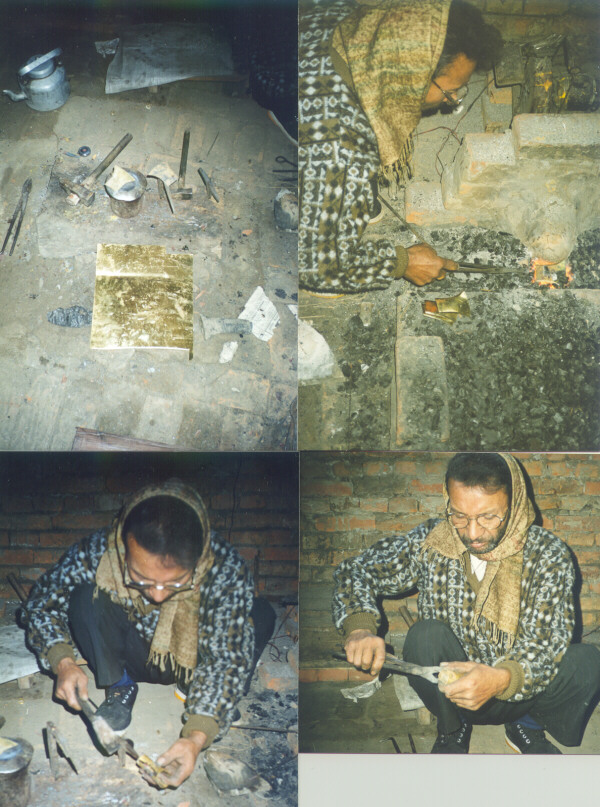
Bura making a handle for a Banspati.
Prakash Bishwakarma [mark of the small khukuri]
Before I left Nepal I gave an assignment to Prakash Bishwakarma, nephew of Bura, the Royal Kami. I asked him to make ten of the strongest 15 inch Ang Kholas he could make and to do the best job he could do. Yesterday I received his effort and I am not disappointed. This is a Chiruwa style 15 inch (actually a little more) Ang Khola. The blade is just about 1/2 inch thick, 2 & 1/8 wide and the knife weighs 2 pounds! This is more than 2 oz. per inch. This knife will outchop anything and I don't see how anybody could ever break or bend it. Here is how I evaluate this khukuri:
Fit and finish -- excellent
Blade hardness -- excellent
Scabbard and frog -- excellent
karda and chakma -- excellent
I am very proud of the effort Prakash has made here. I cannot say more.
Kami Sherpa
Ganga Ram
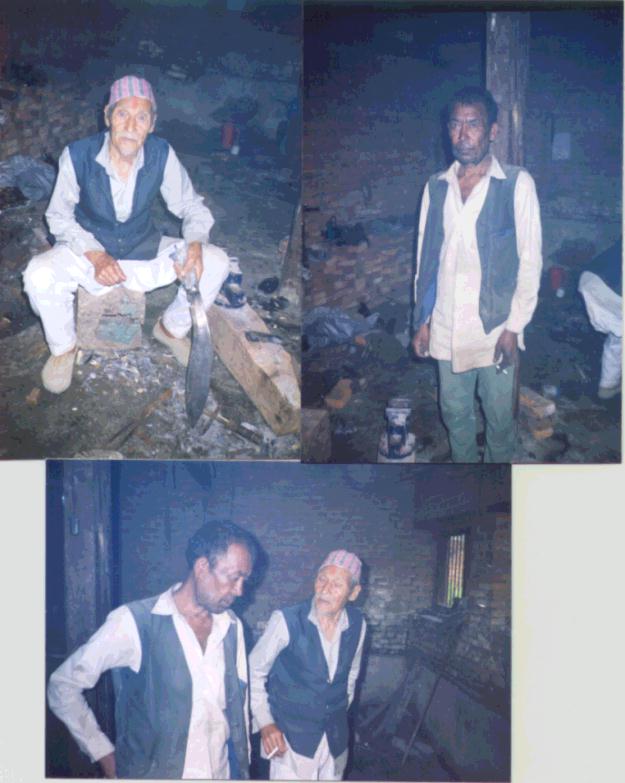
this picture is the shop of the old kami. It is near the village of Udaipur down in SE Nepal. The village cannot be reached by road and travellers must ford a stream of fair size to reach it. Gelbu sent a pix of himself wading waist deep across the stream.
The old kami is 80. The "young" one is 70.
Gelbu, Kami's youngest son, heard about these old kamis on his journey and made quite an effort to go see them and I think it was worth it. When he arrived Gelbu told them who he was, what he was doing, told of Kami Sherpa, me and my Gorkha brother and of Himalayan Imports.
The old kami who is named Ganga Ram Bishwakarma said, "I've heard of you fellows. That American jwai (son-in-law) is the one who does business with that Gorkha boy down near Dharan." He is referring to Til Bai who is in his 60's as a Gorkha "boy."
The old kami goes on. "Well, you tell that American jwai if he thinks that Gorkha boy can make a good khukuri then he has a lot to learn about khukuris. You tell him I am going to make him a "magical khukuri" (I swear -- this is what Gelbu told me he actually said) the likes of which he and few others have ever seen.
We used to make all our khukuris like this when I was young. My grandfather made them, my father made them, and perhaps I am the only kami in Nepal left alive that can make one. But I will make this jwai such a khukuri. Tell him he will never have to sharpen this khukuri. The more he uses it the sharper it gets. And, he will never be able to break it. This khukuri will outlive him and that Gorkha boy and every other man who is alive in this world today. You come back here on your way home and I will have this khukuri ready for you. When our jwai gets this khukuri have him tell you what he thinks about it and then you come back here and tell me. And, that will be my price for this khukuri -- only that you return here and tell me what the American jwai thinks about this "magical khukuri."
Now, boys, this khukuri should be here in a week or so and it is one I really want to see and test a little. Even if it doesn't get sharper with use it is a khukuri that will go into my collection along with this story and a picture of old Ganga Ram. Of course, I will share pictures, review, and thoughts regarding this khukuri. If this one gets lost I am going to cry.
Now you see why I hold these old kamis so near and dear to my heart. What wonderful people they are! I love them.
BILL MARTINO
During my conversation with Kami and Gelbu last night I discovered that
Ganga Ram had changed his mind about making the Ganga Ram Specials in his
own little village shop. He and his 70 year old helper had just arrived
from their village and had started work on their project in Shop 2 only
yesterday.
Although I had mixed emotions about this project and wanted in some
nostalgic way to see old Ganga produce these khukuris in his own shop this
is better. This is the biggest order Ganga has ever received in his 80
years. Although we agreed to supply 3 or 4 young, strong "swingers" for
Ganga to help him pound steel there was no place easily available for them
to eat and sleep. Also, getting any needed materials would take Ganga four
days round trip -- this for some brass that might be needed or perhaps
a new chisel. Ganga and his helper talked it over and decided that Shop
2 simply made more sense.
So, now young Gelbu has four kamis in Shop 2 with a combined experience of more than 200 years and I can see from the Gelbu specials they insisted on making not only are they making him some of the best khukuris in the world but they are also helping him make administrative decisions, too.
Worry about Gelbu and the shop while Kami is gone?-- With those four old kamis around for advice and consent that's one thing I will NOT worry about.
BILL MARTINO
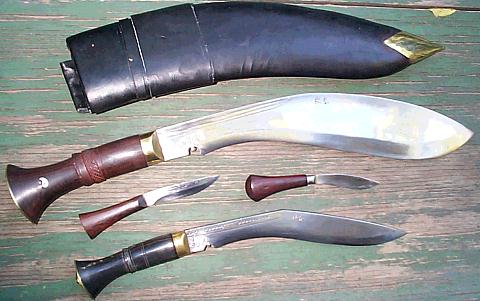
Here is the Ganga Ram Special. The 15 inch Sirupati is there for perspective. This is one of the finest khukuris I have seen come out of Nepal. Ganga Ram has shown us what 80 years experience can do. Ganga has inlaid a yin-yang symbol on this handle. This khukuri weighs 2lb 13oz and is excellently done. Balance point is 10 inches back from the tip. The blade is 1/2 inch thick at the spine. This khukuri is museum quality and tougher than nails. Ganga said he is old but he is not dead yet. - Bill Martino
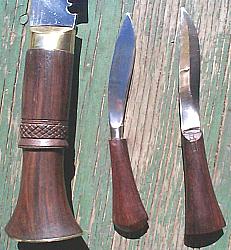
This karda and chakma by Ganga Ram are the best I've seen. Fully functional
and highly polished. - Bill Martino
Review of a Ganga Ram Khukuri
At the khukuri convention I had a chance to pick up one of the khukuris
that Ganga Ram made for HI. A customer had returned one of the several
Ganga originally made, so Bill happened to have one in stock. There was
also an interpretation of the style by Bura. Bill told me, with a twinkle
in his eye, that Bura’s was the better knife.
When I handled them both I found they were very similar. Bura’s was
indeed superior in fit and finish. Bura’s was also thicker, and had a more
perfect forward curve. The weight distribution of the two knives was slightly
different.
Ganga’s seemed to be alive in my hand. I bought Ganga’s.
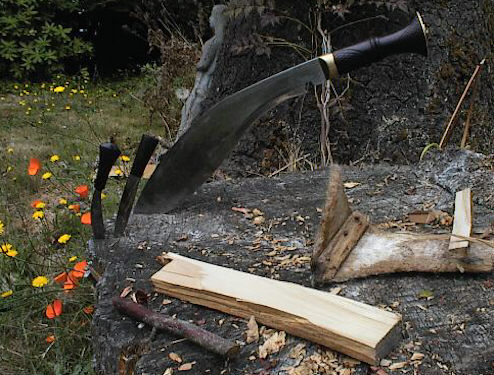
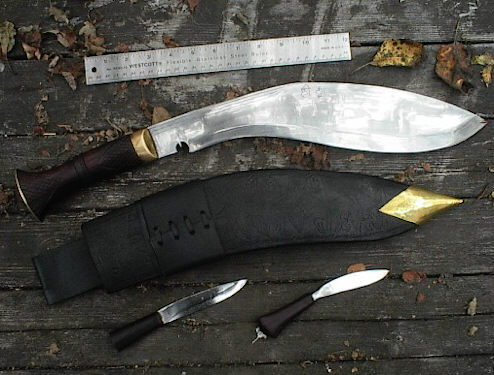
Specs:
OAL - 21.5”
drop - 4”
weight - 2 lbs. 10oz
finish - fine scratches, not mirror
handle – rosewood? with simple checkering and rope carving on central
ring.
I took this knife out to the backyard when I got home. The handle ergonomics are excellent. The checkering is placed in such a manner as to give excellent purchase while not abrading the parts of the hand in contact with the top of the handle. The carving on the central ring also helps to secure the grip.
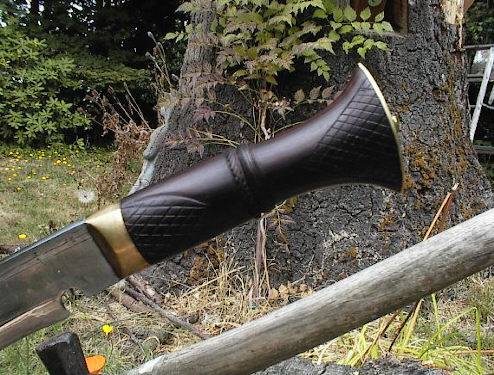
The chakma has a rounded handle, while the karda has a straight one. They are matched yet unique. The chakma is shorter than the karda, as I think appropriate.
This knife strikes true to where thought directs it. It has considerable mass that makes splitting wood a dream. You contemplate the wood and select the proper point to strike. Then you send the knife on its way. The knife gently kisses the wood at the selected point, and the wood bursts apart in joy.
It is evident why the kamis selected one of this old master’s knives for their puja. - Howard Wallace
Old GR's blades (from my experience of seeing only two of them) seem to run about Rc58 at the belly to Rc56-57 at point and recurve. - Dan K.
Ram Bahadur Bishwakarma
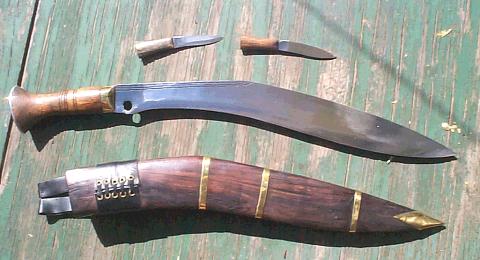
This khukuri was made by Ram Bahadur Bishwakarma, the grandfather of
one of our kamis who works in shop 2, in his own shop. The khukuri is 23
inches in length, about 7/16 thick at back of blade, and is two inches
wide. The knife weighs in at almost exactly 1 KG. It is well done and pretty
well finished. R. B. knew the knife was coming to the US which is probably
the reason it is as well finished as it is. When I run the file along the
blade it sings and tells me it is very decent quality.
The scabbard is what I believe to be black walnut and looks much better
in person than in the above picture. I think the scabbard is wood only
probably because R. B. had no leather on hand. Handle is well seasoned
oak, I think, with flat plate aluminum buttcap with brass keeper. (Remember,
I am no wood expert.) Overall rig very good to excellent quality.
BILL MARTINO
kagas Katne kami – name unknown
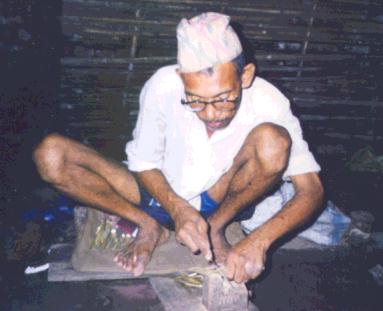
Kesar Bishwakarma [mark of he half sun]
Makes many of the standard items in shop two.
Kumar Bishwakarma [mark of the six pointed star]
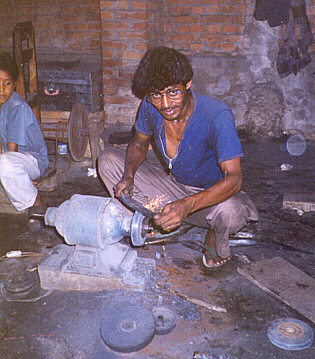
Here is Kumar Bishwakarma, maker of the Kumar Fighter or what I think we will end up calling the Kumar Kobra. As you can see he is a young man but is coming on very strong and is producing some unique and very good khukuris. He does not have his wristwatch yet but one is on the way to him.
Of some interest is the fact that Kumar is wearing eye protection while using the grinder. The Himalayan Imports shop is one of a very, very few to offer eye protection goggles for its workers so they tell me. Also, notice the old bicycle chain driven grinder setting idle against the wall. Our backup system in case of prolonged power loss.
The young boy who is visiting the shop is the son of HI kami Kesar Bishwakarma who makes many of our standard items. - Bill Martino 10/99
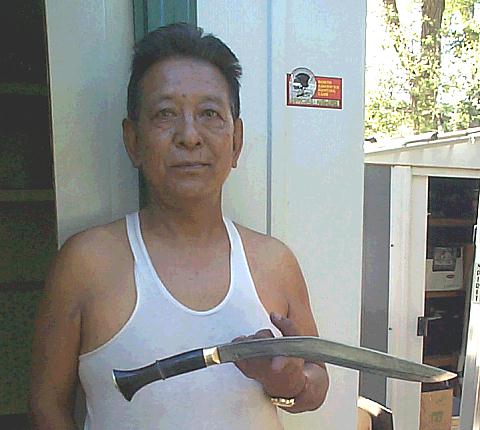
Here I (Kami Sherpa) am holding a khukuri made by one of our younger kamis, Kumar Bishwakarma, who is only 26 or 27 years of age. He asked me if he could make this special version and I told him to go ahead but do a good job. He has done a very good job and I am proud of his effort. He has learned a lot from the older kamis.
This khukuri is made from a file we wore out from use in shop 2. It is the lightest khukuri we have ever made. It weighs only 14 oz. for a length of almost 18 inches. Blade thickness is less than 1/4 inch and only about 1& 1/8 inches wide. Kumar hatchmarked the blade in a very finely done pattern of about 1/16 inch squares and the karda and chakma carry this same pattern.
This is what I think you call here a "fighter." It is not made for use as a prybar. This is for anyone who wants a khukuri that is lightning quick with excellent balance (you can see the balance point from the picture).
Kami Sherpa
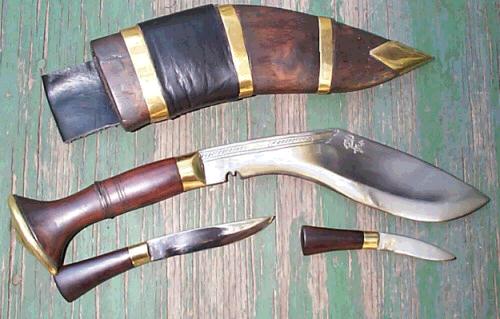
Here is another piece by kami Kumar Bishwakarma, one of our up and coming young kamis who is learning a lot from the old masters. It is 15.5 inches overall and weighs 1.5 pounds. Blade is 7/16 inches thick, about 2.25 wide and excellently hardened. Of interest here is the karda -- 7 inches overall with 4 inch blade. Very nicely done and excellently hardened. This karda will become our standard for all khukuris in the 15 to 18 inch range. It is one of the best I have seen. Bill Martino 10/99
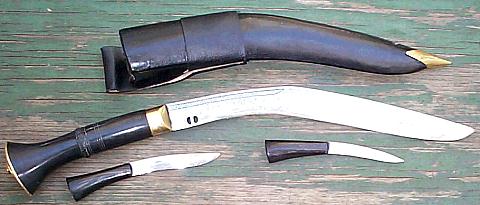
Kumar seems to enjoy making the lightweight "fighters." This one is just a shade under 20 inches, with a 6.5 inch nice sized handle. Blade is 1/4 inch thick and 1.25 wide which looks very strange and weak to me compared to that AK Bowie but our pal, Julian, says his little Kumar fighter is much tougher than it looks so I'm hoping the same will hold true for this one. But I ain't doing my AK lateral strength test on this one!
This 20 incher weighs in at just a shade over a pound. Compared to what I am used to handling this khukuri feels feather light and is very, very quick. Fit and finish are excellent. This blade was made from a worn out file as Kumar likes to do and shows some hatchmarks from the basic file. My file tells me he got a good do on hardening and the blade is razor sharp. Great 6.5 inch karda and good chakma. Scabbard and frog very, very good. Bill Martino 10/99
Sher Bahadur (Brave Tiger) Bishwakarma. [mark of the full sun]
What a name. The surprise was this is Kumar's older brother. Sher had been working in another shop for maybe 15 years but when Kumar told him about the pay and working conditions at BirGorkha Sher quit his old job and signed on with HI. If he does all his work as he does the kagas katnes we have another top quality journeyman kami. Kumar is one of our best and I figure his big brother has to be just as good or better due to his experience.
When I got our first kagas katnes I was impressed with just how well they were done. As you can see from the reviews of this little knife others have been equally impressed. I wondered which kami made these because I thought his work was exceptional. All those kagas katnes were made by Sher Bahadur Bishwakarma. Bill Martino 12/99
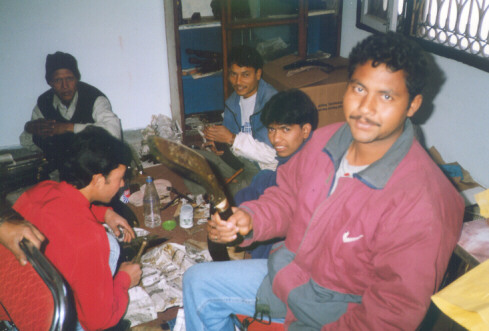
Sher is about 30 and has about 17 years experience. He is showing off one of his 18 inch Ang Kholas. Sher makes the biggest, beefiest, strongest khukuris of any kami in the shop. His younger brother, Kumar, likes to make long, slender blades -- just the opposite. Both men are excellent kamis and excellent workers. When they come to BirGorkha they come to work, not to chat and drink tea. They are both good producers.
This picture was taken in the shipping room. In the background you see
Pradeep, mama, Bhimsen, and an apprentice preparing khukuris for shipping.
"Mama" (uncle) Bishwakarma
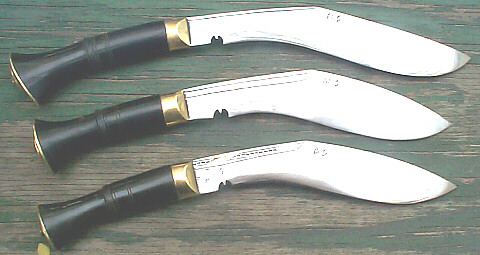
All three of these knives are excellent quality. Made in shop 2 by
"Mama" (uncle) Bishwakarma.
top -- 18 inch WWII style. Blade thickness 7/16 inch and 2 inches wide. Weight is 1 lb 12 oz. SN 132. HI logo. Exellently hardened. High quality frog and scabbard. Karda and chakma 6 inches and well done.
center -- 15 & 3/4 inch Ang Khola. Blade thickness 7/16 + and 2 & 1/16 wide. Weigh is 1.5 lbs give or take an ounce. Excellently hardened. Karda and chakma 5 & 1/2 inches and very well done.
bottom -- British Army Service. Lenth 15 inches. Blade thickness 7/17 and 1 & 7/7 wide. Weight 1.25 lbs. Excellently hardened. Karda and chakma 5 inches and well done.
Khadka [mark of the fish]
Murali Dhar Bishwakarma [mark of the trisul]
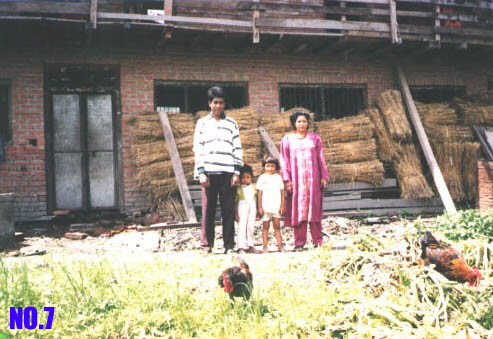
This is Murali Dhar Bishwakarma with wife and two kids. He is the newest member of the BirGorkha staff. They tell me he is about 40 with almost 30 years experience. His mark is the trisul and he seems good about marking the khukuris he makes. The work he has done so far is very solid and shows experience and care.
Murali came with a couple of buddies who worked with him at BirGorkha
for a few days but I don't think they made the grade so they moved on.
BM 6/2000
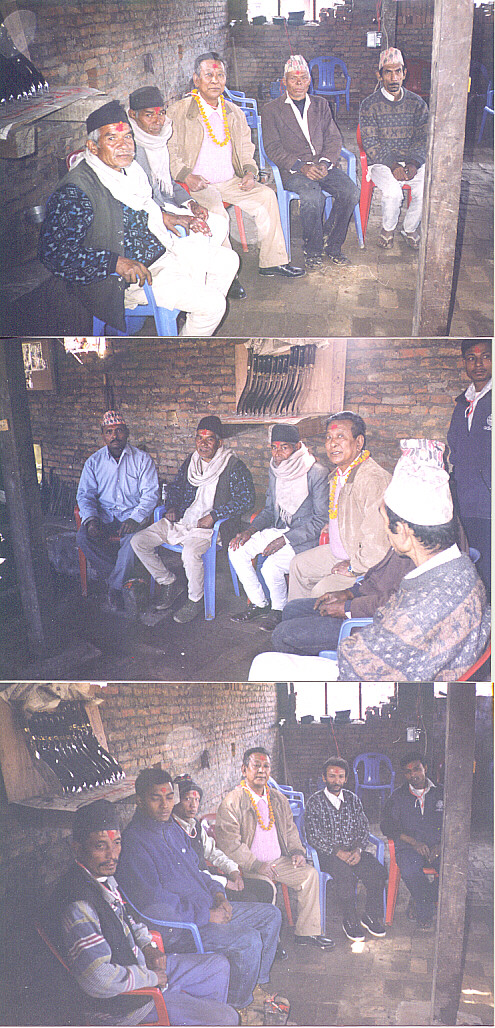
top -- 250 years of experience trading stories.
center -- Sgt. Karka and Sanu join in the discussion.
bottom -- five of the full time kamis, including Bura, join Pala for some conversation.
Notice those who participated in the actual Bishwakarma puja wear the red and white Bishwakarma mala around the neck. I still have mine filed here somewhere.
Bottom pix are guys I dealt with everyday -- from l to r
Kesar
Kumar
Mama
Pala
Bura
Sanu
top pix are the old timers who came in irregularly but I think they are l to r
Krishna
Gorkarka
Pala
Krishna Bahadur
Chandra
Bishwakarma puja is a very serious affair and not given to a lot of merrymaking. Even hough there was plenty of booze nobody got drunk or disorderly.
KB is our senior sarki and can make one of the best scabbards I've ever seen. He is getting his kids educated and they do most of the scabbard work for us.
Krishna - That old fellow is a hell of a kami. He almost never makes
anything anymore but will come into the shop to inspect the work of the
younger kamis and to offer suggestions. He consults with the kamis on new
and special projects. He is a nice old fellow. He was deaf and I had a
hard time communicating with him. My Nepali is not good and his ears are
no good so I had to get a young translator with a good strong voice help
get the job done.
------------------
We called Nepal last night to touch base with Gelbu and got this bit
of information which I must pass on or the kamis will be after me.
The first installment of gifts, T-shirts supplied by forumite John
Powell, arrived safely in Nepal and were distributed to the kamis. These
shirts had a San Francisco-USA motif and the kamis loved them. They actually
danced when they realized these shirts were gifts and they could keep them.
More gifts will be sent over bit by bit to test Nepali customs to see how
badly they hit us. I am a bit concerned about the wristwatches we are going
to send so I will try sending them a couple at a time and see what happens.
However, the important part of this message is this. First, of all the kamis could not believe that HI customers would care enough about them to send gifts. They were overwhelmed by this and kept asking Gelbu if he was sure the shirts came from customers. When they were convinced they pestered Gelbu for two days telling him to make sure that we got the following message so here it is as best as I can remember it -- probably not verbatim but very close.
"We, the kamis who make your khukuris, do not expect you to send gifts. It is enough that you buy the knives we make because this is the greatest gift you can give us. The knives you buy takes care of us and our families and for this we send you not only our thanks but our blessings.
As for the gifts you send, this is more than we expected and more than we can thank you for. Dasein is coming soon and that is a time of great religious significance to us. To Pala, our American Bena, Didi Yangdu, and to all our customers, you can all be sure that you will be in our prayers and our blessings during Dasein. You cannot understand how much all of you mean to us here but we understand very well and not only are the khukuris we send you blessed but all of you are blessed by us as well. We cannot tell you how thankful we are.
We send our blessings, our best wishes and our most sincere thanks."
And, boys, I can tell you for certain they mean every word they say.
Bill Martino
Kamis
1) Kumar Bishwakarma. from eastern side of Nepal
2) Sanu Bishwakarma. " " " "
3) Keshar Lal Bishwakarma. From Kabhre district
4) Lal bahadur Bishwakarma. " " "
5) Prakash Bishwakarma. " " "
6) Khadga ram Bishwakarma. from Bhaktapur
7) Dilip Bishwakarma from eastern side of Nepal.
8) Bhotey Bishwakarma. from Kabhre dis.
9) Ramshran Bishwakarma. from eastern side of Nepal
10) Thuley Bishwakarma from Bhaktapur
11) Murali Dhar Bishwakarma (joined BirGorkha 6/2000)
Scabbard Makers or Sarkis.
1) Ashok sarki.
2) Ragu sarki.
3) Gunthya sarki.
Bill Martino
Here are the marks of our seven full time kamis:
Bura -- cresent moon
Kumar -- six pointed star
Kesar -- half sun
Prakash -- small khukuri
Sanu -- cross
Sher -- full sun
Khadka -- fish
Part timers and visitors will not mark blades. This was what the kamis felt was the right thing to do. We get a lot of visitors and trying to come up with a symbol for each one seemed a little crazy.
Bill Martino 2/2000
More marks
Durba -- flag of Nepal
Kami with no name -- butter lamp (variations of same)
Jag & Prem -- full sun with 4 points at 12,3,6,9
BM 8/2001
Copyright (c) 1999, 2001 by Howard Wallace, all
rights reserved.
This FAQ may not be included in commercial collections
or compilations, or distributed for financial gain, without express written
permission from the author. This FAQ may be printed and distributed
for personal non-commercial, non-profit usage, or as class material, as
long as there is no charge, except to cover materials, and as long as this
copyright notice is included.